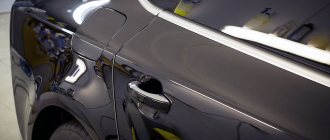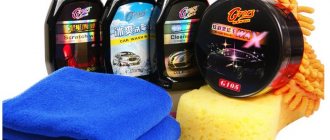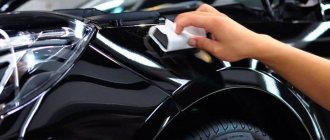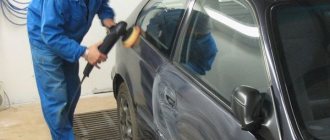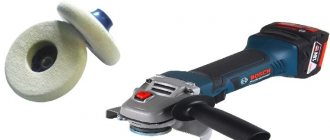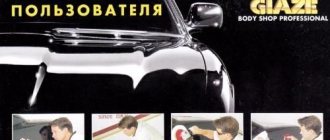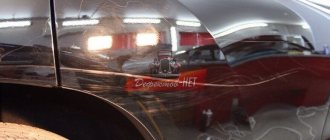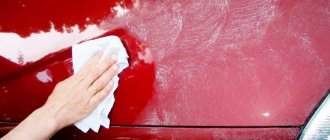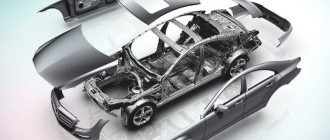Polishing a car body is not only about giving the car the appearance of a new car, but also about eliminating minor damage, scratches, removing the smallest imperfections in the paintwork and protecting the car’s surface from external factors.
The paintwork is very easily covered with microcracks and visible defects. Through these defects in the coating, aggressive substances enter the metal, which cause, at first imperceptible, a corrosion process. The source of corrosion gradually increases and when the owner notices defects, surgical intervention is no longer necessary - a lot of money has to be spent on localization, stopping the corrosion process and restoring the paintwork. Therefore, polishing is also a preventative measure to protect the body.
Catalog of equipment and materials for car body polishing Meguiars, Koch Chemie, Allegrini, , Ceramic Pro, Willson, and other manufacturers
What is polishing
It is impossible to produce high-quality polishing in one go, so the whole process is divided into several stages:
- assessment of the condition of the paintwork, identification and evaluation of defects;
- removal of gross defects - sanding the paintwork using fine abrasive sandpaper (removing the microlayer of paintwork);
- restoration of the paintwork - polishing the body using an abrasive paste (restorative polishing);
- enhancing shine and protecting the body - polishing the body with a non-abrasive paste (protective polishing).
Restorative polishing is used to remove shallow scratches. Their depth does not exceed the thickness of the paint coating layer to the ground. It is also suitable for removing abrasions and oxidized layers. The presence of the latter is expressed in clouding of the paintwork in the form of spots or stripes.
This is the most important and time-consuming stage of body polishing. The process is the mechanical removal of a surface layer with abrasive pastes about 5 microns thick (depending on the grain size). The thickness of a high-quality factory paint coating is now about 100-150 microns, so there are at least about 10-20 polishes in stock without compromising its integrity. If you plan to polish the car body yourself , we recommend that you inquire in advance about the thickness of the paintwork.
Protective polishing is carried out in order to protect the paintwork from subsequent negative environmental influences. It is produced using non-abrasive polishes based on waxes or synthetic materials.
Complete set for car polishing here (select and buy with delivery)
Execution technology
High-quality polishing is carried out in several stages:
- Surface preparation: drying, cleaning, identifying the most defective areas and scratches, degreasing the surface, gluing with tape. Applying polishing clay to a clean body. This will remove any remaining debris. If more serious chips down to the metal are found on the body, they will subsequently be noticeable. Therefore, such damage must be eliminated by painting it with varnish and then treated.
- Grinding with abrasive paste. At this stage, deep scratches are eliminated. The abrasive removes paint coatings up to seven microns thick. The master uses polishing discs onto which abrasive paste is applied. This is the longest and most labor-intensive process that requires certain skills. It is necessary not only to eliminate scratches, but also not to spoil the paintwork.
Polishing wheels also vary in hardness. They are usually distinguished by color: white, orange, blue, black.
The first two have a hard and medium-hard texture. Craftsmen also use polishing machines and eccentric machines. The abrasive paste works at speeds from 900 to 2000 rpm.
- Restorative grinding with fine abrasive paste. Minor risks and scratches are eliminated.
- Protective sanding with non-abrasive paste. Body protection and shine enhancement. For final polishing, use soft polishing wheels in black and blue colors.
Polishing pastes
When choosing a particular polishing paste, you must first assess the condition of the paintwork. If the car is almost new or the body is only slightly cloudy, then you need to opt for a polishing paste with a low content of abrasive particles, or without them at all.
You can also use certain polishing systems for freshly painted surfaces, such as the Solo system from Meguiars :
To restore the paintwork, the body will have to be pre-treated with a polish with a high content of abrasive elements.
You need to know that the properties of the polish largely depend on the components that make up the polishing paste. Protective polishes based on waxes and silicones are easy to apply and also easy to remove. After two or three visits to the car wash, this polishing will have to be done again.
In terms of durability, polymer polishing pastes undoubtedly win, and, importantly, without sacrificing quality. It is enough to apply such polishing compounds once every six months. But the cost of such polishing pastes is significantly higher than their wax and silicone counterparts. In addition, their application is more labor-intensive, which is why much more time is spent on polishing with polymer compounds.
Catalog of polishing pastes: abrasive polish, protective polish, anti-hologram paste Meguiars, Koch Chemie, Allegrini, 3M, Ceramic Pro, Willson and other manufacturers
Where do circular scratches on the body come from?
You can often notice circular scratches on your car. They appear to be left by something that applied them in a circular motion. In fact, they appear circular in the sun or under artificial light because the sharp edges of the thin scratches catch and reflect light emitted outward in all directions from the central point of illumination. If you look at the same panel, but under diffuse lighting (not focused), you will find that thin scratches are located randomly in all directions and no longer look neatly round. That is, they look circular only under some kind of point (focused lighting, for example, under the rays of the sun), only the edges of the scratches around this illuminated center are visible.
Preparation for polishing
To polish the body, the following conditions are required:
- the car is washed clean, there are no traces of bitumen, anticorrosive or other dirt on the body; Body cleaners are here.
- chips and scratches “down to metal” are carefully covered with special tape;
- the machine is not in direct sunlight;
- the room in which the car is polished must be well ventilated, as a large amount of dust can be generated during work;
- sufficient light is required. It is advisable to place the light at 5 points to evenly illuminate all painted surfaces of the car, ideally achieving uniform illumination of the body from all sides, otherwise some scratches and abrasions may escape the eye.
In addition, before starting polishing, it is necessary to cover all plastic and rubber parts on the car body with masking tape.
Expert advice
For polishing to be effective, you need to listen to the advice of experts:
- To eliminate dust in the room, you must regularly wet the surfaces adjacent to the car using a spray bottle of water.
- If the car wash did not cope with traces of oil and bitumen, you need to remove them in another way. But using sharp objects is not recommended. An ordinary plastic card helps to clean such damage well.
- Using water when using sandpaper will prevent it from clogging quickly and will protect the coating of the machine.
- To get rid of large scratches, sandpaper with an index of 1500 is used; minor defects are corrected with sandpaper with an index of 2500. The paper is processed using movements in a circle and diagonally in different directions.
- Polishes dry very quickly, in about 5 minutes. It is necessary to rub the surface intensively so that the substance is distributed over the coating.
- Polishes should be shaken well and applied to small areas so that they can be rubbed evenly. It is better to take a plot area of 50x50 cm.
- For a good result, you need to choose special polishing cloths. They usually come included, but get dirty quickly. It is better to buy them additionally.
- It is recommended to apply a small amount of polish. It's easier to add if necessary than to remove excess.
- It is not recommended to polish your car at low temperatures. Polishes may change their consistency.
- It is not advisable to buy low-price polishing products. When purchasing, it is better to focus on brands with additional functions.
- When polishing a car, you cannot do other work in this room that raises dust, for example, primer. The settling of even the smallest dust on the surface of the car will ruin all the work that was carried out previously.
- You can find modern nanoceramic polishes on sale. CERAMIC and NANO POLISH compositions are valued for their high quality.
Knowing how and with what to polish a car at home, the car owner can always return the car to its original shine and increase the protective properties of the body. Using simple devices, the machine quickly takes on its previous appearance. Polishing also provides long-term protection for the body. With each successive polishing, you will gain experience and develop skills that will help you perform actions accurately, clearly and professionally.
Body polishing
For polishing you will need:
- polishing compounds of various types, depending on the damage to the body paintwork - abrasive, medium-abrasive and non-abrasive;
- polishing machine;
- polishing wheels;
- microfiber cloths or microfiber towels.
To obtain a high-quality result, it is necessary to polish the car body several times using different compounds. The car polishing procedure begins with an abrasive (medium abrasive) composition using coarse (medium) circles to remove, respectively, deep (medium) scratches.
A small amount of polishing compound is applied to the wheel and polished by moving the polishing wheel evenly over the workpiece. At the first stage, polishing is carried out with an abrasive material at a polishing machine speed of 1000-2000 rpm.
In no case is it recommended to press the machine tightly against the surface to be treated and to linger in one place for a long time, as this can damage the paintwork down to the ground, and then repainting the part will be necessary. Particular care must be taken when polishing the corners and edges of the body part.
To perform polishing efficiently, do not rush and cover a large area at once. For those who are polishing the body for the first time, we recommend that you try first on an inconspicuous area, and ideally, practice on some unnecessary part: the hood, fender, etc., if it is available.
Make several horizontal movements without pressing the polisher too hard against the surface. After that, evaluate the result. It depends on the degree of pressure, the polishing wheels and pastes used. You must feel and understand how noticeable the impact of polishing on the body is and, accordingly, adjust the speed of passage, the number of passes and the degree of pressure on the polishing machine.
Directly when polishing a car, after several passes with the machine, inspect the treated area, after wiping it with a napkin. If there are no scratches left, move on to the next part of the body (next row). Try to polish so that the next row minimally overlaps the previous one; ideally, they should run parallel.
After such restorative polishing, the body will look like new. However, if the car is constantly in use, this will not last long (from several weeks to several months). In order for the appearance to be preserved for a longer period, it is necessary to perform protective polishing .
The main difference between protective polishing and restorative polishing is the use of non-abrasive polishing pastes. To carry out protective polishing, you will need to increase the rotation speed of the grinding machine wheel to 3000-4000 rpm, and replace the wheel itself with a softer one.
The essence of protective polishing is that a polish is applied to the car body, protecting the paintwork from external factors:
- moisture;
- ultraviolet radiation;
- chemical substances;
- mechanical impact, etc.
At the same time, it is necessary to ensure that the polishing paste does not get on those areas of the car that do not need to be processed: plastic door handles, chrome parts, rubber moldings. This is due to the fact that after complete drying, the polish in these areas may appear in the form of matte deposits, which will not be so easy to remove.
The overall lifespan of the polish will depend on many factors. These are reagents in winter, sun in summer, quality and number of car wash visits. On average, the service life of protective polishing is about 6 months.
Thus, you can make a preliminary list of equipment and necessary consumables to perform a full car polishing cycle, based on Meguiar's materials:
When should you contact specialists?
Polishing car wheels: what is it for and how to do it correctly
Every car owner should understand what polishing a car body does. This is not just a desire to give the car a beautiful, respectable look. This point is also important, but the coating of the external metal profile of the car deserves special attention. Professional processing, qualified service, high-quality polishing of scratches on the car body:
- restores the prestigious appearance of the car;
- maintains the attractiveness of paint and varnish coatings;
- extends the service life of the body.
- helps with pre-sale preparation, will increase the cost of the car and create the appearance of a new body. It will be difficult to determine the mileage of a car by eye.
Experienced, qualified technicians perform car scratch removal at our service center. They are well versed in the nuances of coatings. Japanese cars have a thinner and softer layer of varnish, so rough impact is not recommended for them. German and Swedish cars have a coarser and thicker layer of varnish; any type of treatment can be applied to them and there are more possibilities there. Polishing car scratches in our center is carried out at the proper level. We use only proven, reliable products in our work: Menzerna, FEESTOL, EXTREM PLUS, etc.
The easiest way to remove scratches on a car body is if they were made recently. The damage in this case is not serious, the structure of the paint layer is not destroyed, and has not yet spread to the metal components. Therefore, polishing the car body, performed immediately after damage occurs, has maximum efficiency. Prompt professional removal of scratches on a car guarantees the preservation of its aesthetic characteristics. Moreover, prompt polishing of car scratches will cost less than thorough treatment of “old wounds.”
Professional polishing of car scratches immediately after damage eliminates premature damage to the paintwork. Therefore, timely qualified polishing of the machine is an excellent preventive measure to extend its service life.
Polishing a car body is one of the main procedures that can increase the service life of a vehicle. Restoring the integrity of the paintwork, making it reliable, guarantees high-quality protection of metal body parts. Our car polishers use only proven, reliable products. This guarantees high quality results.
There are 3 types of polishing:
- The most gentle is anti-hologram, performed with the finest-grained paste, which helps restore shine, but does not remove scratches.
- The second is soft polishing - the car has already passed a certain number of kilometers, but in fact it is still new, the service life is about six months, a medium-grain and anti-hologram paste is used.
- The third is abrasive polishing, coarse-grained, medium-grained pastes and anti-hologram treatment are used. It helps to achieve maximum shine and remove fairly deep scratches and so-called prisms or holograms that appear on dark car colors in the bright sun, but at the same time the layer of varnish removed from the paint will be quite significant.
The main advantage of our service is the use of innovative materials and the latest technologies. Our craftsmen use only proven, reliable coatings from well-known manufacturers. A layer of the product completely covers the body, filling the smallest cracks, providing a perfectly flat surface. This provides the car with protection and a luxurious look.
Primary processing (preparation for main polishing)
It is necessary to remove small inclusions of dirt in the paintwork
- For this you will need:
- Synthetic clay Detailing clay C2000 / C2100 or others. We choose the appropriate one depending on the type of contamination.
- Final inspection cleaner M34. A universal surface cleaner, a quick way to remove residual working product (including polishing paste) from the surface.
- Cleaner Last touch spray detailer D155. Can be used instead of Final inspection (simpler and cheaper alternative).
Assessing the condition of the varnish, sanding the surface. Removing rough scratches
- For this we need:
- Abrasive sheets Unigrit finishing papers. This is sandpaper with a gradation from 1500 to 3000 grit. The peculiarity of its use is that before use it must be soaked in soapy water for at least 15 minutes.
- Holder for sanding paper for example Hi-tech backing pad E7200. Used in conjunction with Unigrit finishing papers. Ensures uniform load distribution on the sanded surface.
Attention! Always make progressive movements with sandpaper in one direction (at least in perpendicular directions). Never make circular or random movements.
Classification of scratches
It is customary to divide all encountered defects of this type into several varieties. There are scratches to the base, to the paint and to the varnish, and the latter are divided into ordinary and deep. And then there are also slippages. The last option is the most dangerous: there may be various defects to any degree. Rubbing in occurs when the body touches other cars, trees, branches, fences, etc.
Polishing is guaranteed to remove shallow defects from rubbing in, and at the same time restores the color. And more serious damage after it will be less noticeable. But this will not help the furrows down to the very base.
Scratches to base
By default it is metal, but in recent years, plastic has increasingly become the basis. In both cases, polishing will not help. Such furrows can be seen from afar, from any angle and even in low light. And in color, they differ from the body, the above-mentioned checks do not pass.
It must be said that scratches to the very base do not appear after washing or from a brush, even the hardest. Most often this is the result of vandalism: when someone deliberately damages the body with a nail or any other hard, sharp object. Also, deep grooves often appear during an accident, along with dents.
If you still try to polish, the defect will decrease slightly, but the result will be too weak for a meticulous inspection of the car owner. You'll have to go to the workshop and repaint the car.
Scratches to paint
They are also visible under water and can be caught with your fingernail. From scratches to the base, such defects differ only in color: they are less noticeable precisely because they do not differ in color from the body. The reason for the appearance is also often vandalism or an accident, careless parking. These defects are deep enough that a good master will not undertake to polish them in the first place. You can grease or mask it temporarily until the car is repainted.
Scratches on varnish
The majority are like this and I really want to polish them. Moreover, in both tests, ordinary scratches on varnish pass immediately: you can’t catch them with your fingernail, no matter how hard you try, and you won’t be able to see them under water either. This is where polishing really helps.
Unfortunately, there are many opportunities to again cause defects in this category to the body: rub the dirt with a sponge, wipe off the dust with a dirty rag, press hard on the napkin - and here they are. It gets ridiculous: passers-by in the parking lot touch the body with a bag or zipper - again, scratches.
Deep scratches in the varnish deserve special mention. This is approximately at the border of the paint and varnish layer. If you polish, you can remove the remaining varnish - and then you will have to repaint. Compounding the problem is the difficulty of assessing the depth of a scratch in a particular case. It feels like it barely clings to your fingernail, and is almost invisible under water, especially in low light. The price of a mistake is removed varnish, etc.
In practice, any scratches on the varnish are polished, provided that it is done professionally. For example, deep ones can be removed by sequentially using different sandpapers: from 1500 to 3000. By the way, keep in mind: sandpaper larger than 1500 is generally not suitable for polishing a body; it is a tool for carpentry work.
Polishing
Removing the effects of sandpaper treatment and polishing the surface. The choice of polishing paste depends on the degree of damage and the preliminary polishing.
| If grinding was carried out | If sanding has not been carried out |
|
|
After basic/restorative polishing, it is advisable to perform protective polishing
For this purpose, various compositions based on waxes and synthetic polymers are used. Depending on the composition, such protection lasts and functions differently.
- For example:
- Hi-tech yellow wax M26. Processing is done manually. Excellent yellow Carnauba wax. Restores color depth and brightness. Recommended for use during the dry season.
- Polymer sealant. Processing is carried out manually, with a machine of planetary, double or simple circular action. A unique composition of polymers, silicone and waxes. Gives a sparkling, long-lasting shine. Recommended for use in winter.
- Synthetic sealant 2.0 M21. Processing is carried out manually, with a machine of planetary, double or simple circular action. Versatile synthetic polymer provides deeper, brilliant enamel color. Suitable for use in both winter and summer.
a complete catalog of tools and materials for car body polishing, see the catalog section.
Polishing technology from Meguiars (click on the image to enlarge):
Advantages of professional processing
You already know how to polish a car yourself. The procedure is not easy when it comes to restorative treatment. But many stubbornly continue to do everything on their own, ignoring the services of auto repair shops. Nowadays, it is not difficult to find instructions and tips on how to polish a body without outside help, using available tools and materials available in any store. But most of these methods involve gentle polishing, which is done using no more than 2 buffing wheels, one paste and a couple of finishing rags. You should not expect incredible results from such a procedure that will last for months. No one gives a guarantee of high-quality polishing. Only a few amateurs can achieve results similar to professional processing. And for this they will have to put in a lot of effort, time and nerves. If you choose professional polishing, you will receive the following benefits:
- Several polishing materials with different purposes and effectiveness are used at once;
- professional equipment is used during processing, which is extremely unprofitable to buy for personal use;
- Often at least 2 specialists are involved in polishing one car;
- polishing materials are selected based on many factors that can affect the final result;
- Experienced specialists work on the machine, which minimizes any errors and errors.
If you encounter fairly serious damage to the paint layer, it is better to entrust the work to trusted professionals. Each car owner decides for himself how and how often to care for his own vehicle. Some devote time to their car literally every week, others only wash their car occasionally, and can only dream of polishing their car. It’s not difficult to guess whose car will last longer and look much more attractive. The choice is yours.
Average cost of service:
- deep polishing – from 4800 to 10100 rubles,
- polishing one element – from 280 rubles,
- headlight polishing – 290 rub. for a unit.
The price of these works may vary depending on the prestige of the service station, the brand of the car and its size, urgency, and the type of materials used.
In addition to deep polishing, there is also soft, protective and restorative polishing.
Below is a video - a tutorial on polishing scratches with your own hands.
